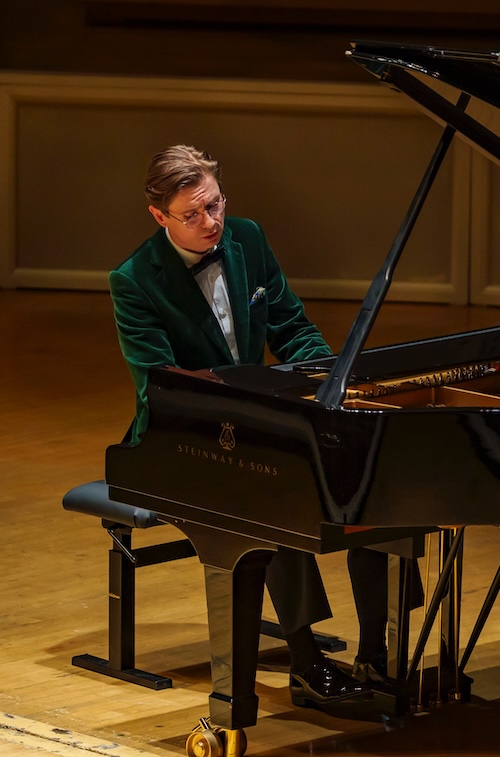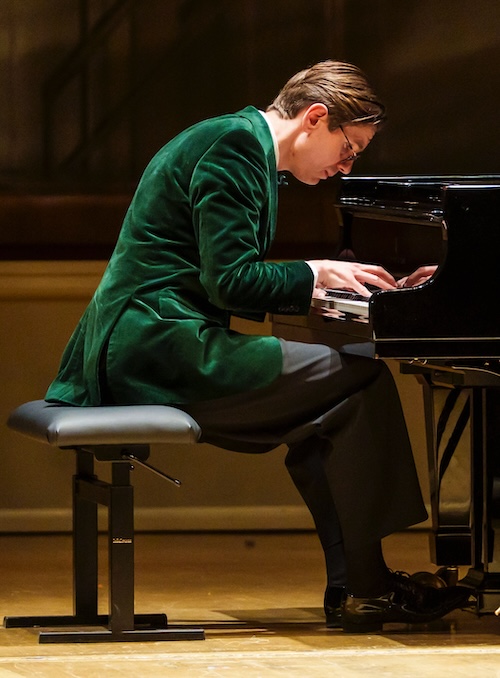Ólafsson brings rarefied artistry to Bach, Beethoven and Schubert

It has been a jam-packed weekend for pianophiles.
The three-week Van Cliburn Competition reached its climax Saturday night with Aristo Sham of China winning the Gold Medal.
And on Sunday afternoon, Víkingur Ólafsson returned to town, following his acclaimed Chicago debut of two years ago, and drawing a rare, near-capacity Symphony Center audience.
The Icelandic pianist is a singular artist of interpretive depth, luminous colors, and acute sensitivity. He has built an international following via his best-selling series of Deutsche Grammophon recordings, ranging from Bach and Rameau to Mozart, Debussy, and Philip Glass.
Sunday’s program, unusually for Ólafsson, concentrated on core German repertoire with sonatas by Beethoven and Schubert and a keyboard suite by Bach. Yet, as always with this artist, his unique presentation is as much a part of the event as his musicianship.
As he did in 2023, Ólafsson played the 90-minute program straight through with no intermission and barely a pause between works without ever getting up from the bench.
This concentrated presentation proved highly effective, making one meditate on the necessity (and wisdom) of traditional program conventions. Regardless, the unbroken span seemed too much to digest for some audience members who bailed early—perhaps getting lost amid the continuous 15 individual sections—and/or requiring applause breathers or rest breaks.
The pianist began the afternoon with Bach’s Prelude No. 9 in E major from Book I of The Well-Tempered Clavier. Rendered with great delicacy, this gentle introduction offered an ideal starting point, setting the program’s E major/minor tonal scheme and conveying a kind of “Once upon a time” atmosphere to begin the musical journey.
Ólafsson followed with the first of two late Beethoven sonatas, No. 27 in E minor, Op. 90, firmly contrasting the themes of the opening movement. The main motif of the second (and final) movement was ideally songful as Beethoven requests, segueing into rollicking affirmation before pulling back to a quiet, glowing coda.
The program’s dominant feeling was one of somber reflection, as evident by the centerpiece of Bach’s Partita No. 6 in E minor, the most inward of the set. Ólafsson, who closely observed repeats throughout, built the vast fugue of the opening Prelude into a staggering display of contrapuntal brilliance while maintaining striking clarity of line. A Bach player of great insight and sensitivity, he varied the dance inflections of the ensuing movements with subtle nuances and shifting tonal hues. Unfortunately, the hushed inward expression he brought to the Sarabande was broken by the loud clanging of a retro cellphone ring. That broke some of the spell before Ólafsson managed to recreate the previous hushed reverie in the repeat.

At the conclusion of the scheduled concert, Olafsson revealed that the idea behind the program was really “the birth of Schubert” and the Beethoven and Bach influences that went into his compositions, as manifest in the Piano Sonata in E minor, D. 566. If that intent wasn’t wholly apparent in the program’s trajectory or the sonata’s performance, this was idiomatic and superbly realized Schubert by any measure, dramatically taut with a cast of underlying tragedy that remained even through the cascading passages of the Allegretto.
And so on to the final work, Beethoven’s Sonata No. 30, Op. 109, coming full circle to the E Major that started the afternoon with the WTC Prelude. Ólafsson brought a fresh and guileless quality to the opening Vivace, qualities broken apart by the ensuing Prestissimo with its agitated sturm und drang.
Ólafsson played the hymn-like theme of the finale spaciously, distinctly characterizing the four variations while keeping an overall sense of elevation. The pianist closed the sonata—and the afternoon—with a reprise of Beethoven’s theme that was even more transporting, rendered with a benedictory glow that seemed imbued with consolatory transcendence.
The applause was long and loud, repeatedly bringing back the pianist, who affectionately patted the Steinway. Ólafsson had not spoken a word all afternoon but finally let his charming personality off the leash. “I love your city, I love your orchestra, and I love this piano!”
As inspired as the scheduled program had been, Ólafsson saved some of his best playing for the encores, each rendered with the finest of expressive and tonal shading. First was a stately and eloquent rendition of the Adagio from Bach’s Concerto in D Minor (after Marcello), BWV 974 (“Bach and not Bach,” as he called it), followed by a breezy rendition of Rameau’s rippling Dialogue of the Birds.
Ólafsson sent the assembled masses home with his own transcription of “The Arts and the Hours” from Rameau’s Les Boréades—the sublime melody rendered with an otherworldly expression that was all the more moving for its understatement.